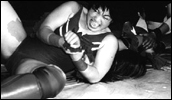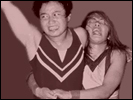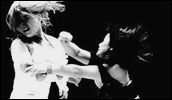Gaea Girls
- Year
- 2000
- Original title
- Gaea Girls
- Director
- Cast
- Running time
- 104 minutes
- Published
- 25 June 2001



by Jasper Sharp
I have to confess that my personal knowledge of wrestling amounts to little more than distant memories of the spectacle of overweight middle-aged men in leotards such as Big Daddy and Giant Haystacks bouncing around UK TV screens during the 1970s. Its combination of tawdry pageant and crowd-pleasing choreographed violence seemed to keep the kids amused (not to mention a disturbingly large proportion of post-menopausal women), yet rather stretched any definitions of athleticism. Still, that was a different time and a different place, and in other countries the sport has considerably moved on to develop into a multi-million dollar industry. If you don't believe me, then I urge you to check out this eye-popping documentary on the Japanese female wrestling team Gaea Japan and the girls who pass through its harsh regime in their quest to join the ranks of fully fledged women pro-wrestlers (joshi puroresu).
The Gaea Japan training camp is a large white hut in the middle of nowhere containing a wrestling ring, with the obligatory Pocari Sweat vending machine attached to the wall outside. It also plays home to a group of girls in their early 20s all aspiring to make it on the Pro Wrestling circuit and their androgynous tyrant trainer and Pro Wrestling superstar Nagayo. At the heart of this film stands Takeuchi, who even before the film started shooting had already spent a year trying to qualify for her public debut. The film follows her repeated attempts to launch herself into the puroresu arena, and the (quite literal) buckets of blood, sweat, and tears shed in the process.
Believe me, if you've ever doubted the veracity of what goes on in the ring itself, the behind the scenes training footage here will scotch any suggestion that the sport is the glamourous soft option suggested by its glitzy public façade (though it is never stated in the film, co-director Jano Williams let it slip in the Q&A session after the festival screening where the film was viewed that although injuries and the occasional fatality are a regular occurrence on the Pro Wrestling circuit, the actual bouts themselves are fixed).
There is a lot of emotionally harrowing footage on show here as Takeuchi rides the punches in her harsh training regime with an unbelievable strength of will. In her initial test, we watch as she repeatedly hurls herself against Nagayo (who has at least a 6-inch height advantage over her) in a succession of ineffectual dropkicks, before her opponent finally floors her with a devastatingly brutal kick to the face. The following scene sees Takeuchi gurgling apologies for her failure through streams of tears, and a split lip gushing blood as her unforgiving coach berates her with a series of harsh cuffs around the ear for her weakness in the ring. The frustration in her eyes is tangible, as by her third attempt in the film, the dumpy Takeuchi still hasn't qualified to debut.
However, if all this seems too bleak a prospect for over an hour and a half of viewing, the directors do manage to intercut Takeuchi's seemingly fruitless pursuit of her dream with some more touching footage of the bonhomie and team spirit of the trainees outside of the ring. In one scene, the girls giggle uncontrollably, semi-conscious of the camera watching them as our dogged lynchpin has her fringe cut upon the advice of her trainer to make herself more attractive for the spectators ("You look like an egg now!", one of Takeuchi's co-wrestler's shrieks). There are some poignantly incongruent shots of Satomura, a fellow wrestler having her hair done prior to the match, during which the camera pans up from the butch fighter before she enters the fray to reveal, in a neat piece of sexual role reversal, her rather effeminate looking peroxide-headed male hairdresser.
And then there's the trials and tribulations of her fellow wrestlers. One girl quits the training camp after Takeuchi's public hammering by Nagayo and is showered with abuse by the terrifying mentor. There's also the demure new arrival Sato, with her raven-black hair tied back in pigtails and gorgeous blue eyes she looks far too fragile to go the full distance. It looks unlikely that she'll survive 5 minutes even in conversation with Nagayo, let alone hand to hand combat, but will she go the same way as the graceless Wakabayashi, who absconds overnight after one squat thrust too many during the early rigours of the initial training period?
The production team linger at an objective distance throughout the whole film, with only one talking head interview with Takeuchi (all bobbed heads and nervous smiles) at the beginning of the film in which she explains the appeal of the wrestling world ("they are so alive, they shine") and another with Nagayo (who clearly has her own personal demons to exorcise) coming later on. However, I do feel some sort of background information into the social context and state of the Japanese Professional Wrestling would not have gone amiss (remember that sumo is one of Japan's biggest sports), and also a little more insight into the girls themselves would have helped to round things out a little more. Details such as the fact that during the girls' training period before they qualify to fight professionally they survive on mere pocket money, and that outside of wrestling the girls face little more than the prospect of a lifetime of supermarket work or similarly lowly employment, all came out in the Q&A session (apparently Sato is now working in a garage shop), but surely such exposition falls well within the scope of the film itself?
At the end of the day however, Gaea Girls makes for incredibly rewarding viewing. However brutal events get on the canvas floor, what truly comes across here is the discipline and dedication to their dreams these girls share, not to mention how sweet and nice and generally unaggressive they all seem. The film is by turns shocking, exhilarating, inspirational, and touching. It opens a window on an unknown world whilst eschewing any attempt at trying to probe too deeply into the psyches of its subjects.
Funded by the BBC and directed by the two women who gave us the 1998 talking point TV doc, Divorce Iranian Style, Gaea Girls got its first airing on British TV early in 2000. That the directors manage to infiltrate into the milieu so unobtrusively is a testament to their familiarity with Japanese culture and concern with women's issues that has already left its mark in a series of similar wide-ranging documentary pieces: Eat the Kimono (1989), a focus on the avantgarde dancer Genshu Hanayagi; The Good Wife of Tokyo (1992), in which Kazuko Hohki, frontwoman for the eccentric London-based band The Frank Chickens returns to Japan to marry her English boyfriend of 10 years; and Shinjuku Boys (1994), about the female regulars of Tokyo's "New Marilyn" nightclub, who dress and live as men.